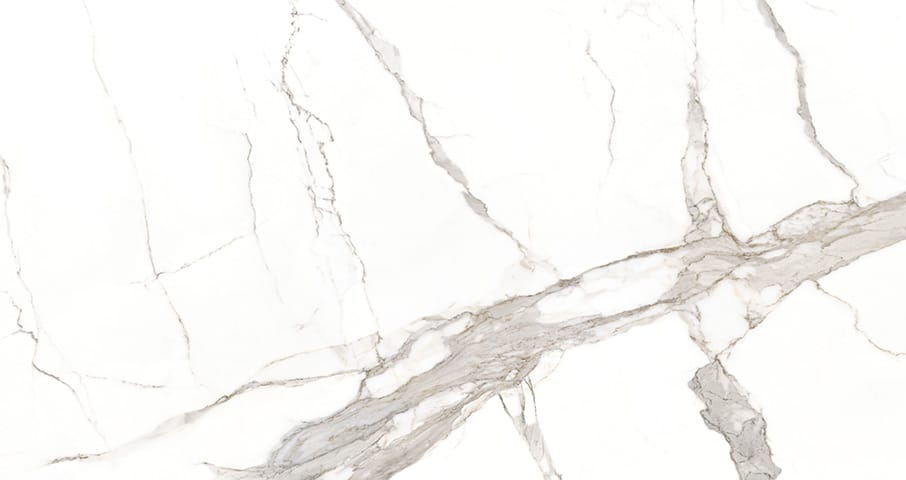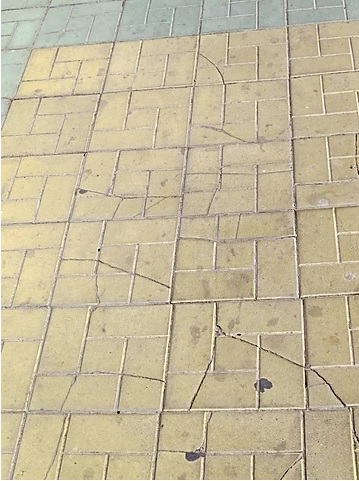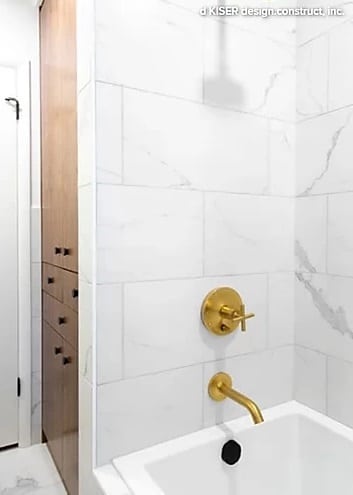Most homeowners are familiar with porcelain tiles, which are frequently used for flooring and backsplash. But is it an appropriate material for an entire countertop, vanity or kitchen island? Lately, porcelain has gained attention as a kitchen countertop material.
Most homeowners are familiar with porcelain tiles, which are frequently used for flooring and backsplash. But is it an appropriate material for an entire countertop, vanity or kitchen island? Lately, porcelain has gained attention as a kitchen countertop material.
Let’s take a look at how porcelain compares to natural stones such as granite and marble as a countertop surface.

Statuario Bari Matte Porcelain Sample
Choose your design carefully if you choose porcelain countertops
Porcelain slabs may have artificial patterns printed on them. Keep in mind that that pattern is only on the surface of the material. Unlike stone, porcelain slabs do not have true “veins” or patterns that extend through the material.
What does this mean for your countertop? You may not see the patterns along the edge of the counter. Certain edge profiles will not look as clean as they would with a natural stone, such as granite or marble, which have veins or patterns throughout the slab.
If you’re seriously considering using porcelain as your countertop surface, ask your installer what type of edge profile they recommend. Make sure you understand how the finished product will look along the outside edges and inside of the sink cutout.
Porcelain countertops tend to get chips and cracks
Porcelain may chip on impact with a heavy object. And repairing that chip or crack is no easy task.Since the pattern on the surface of the slab does not extend through the stone, a chip could potentially be very noticeable. If a chip or crack occurs anywhere on the printed pattern, the mark will be a visibly different color.
Chips can be repaired with material that matches the color of the slab. But the repair will not match the exact pattern printed on the surface of the slab. So while the countertop may still be functional, the chip will always be visible.
Natural stones, on the other hand, don’t frequently get cracks or chips from normal household use.

Cracked porcelain may be impossible to repair completely.
Scratches cannot be repaired
Fortunately, porcelain is relatively durable and unlikely to scratch. But if your porcelain countertop does get scratched, you’re probably out of luck.
Cracks and scratches on porcelain cannot be fixed entirely. Glue can be applied to hold the stone together and fill the crack, but the crack or scratch will always remain visible. Porcelain cannot be re-honed the way natural stone can.
Porcelain is a man-made product. And it shows
There are a wide range of porcelain color options available. But if you’re drawn to the look of marble or granite, you just can’t beat the real thing.
We’ve come a long way in recent years in our ability to replicate the look of natural stone. Porcelain and engineered quartz manufacturers are constantly looking for ways to mimic the appearance of marble or granite. But porcelain looks distinctly different from natural products, which have unique variations in color and patterning.
The aesthetic of natural stone has been popular for decades. Porcelain, on the other hand, came on the scene only recently as a viable countertop option. It remains to be seen whether porcelain countertops will hold their value and still be in vogue several years down the line.

Digitally printed porcelain makes for a beautiful wall, but may not hold up to the wear and tear of a countertop surface. Photo courtesy of Houzz and d KISER design.construct, inc.
While porcelain is a beautiful and reliable material for backsplash and floor tiles, it has some vulnerabilities as a countertop material. Homeowners should do their research to fully understand the functionality of the material when it’s exposed to daily use, rather than simply being drawn in by the beautiful designs.
If you have any doubts about the material you’ve chosen, partner with a trusted countertop fabricator to get a professional opinion.







